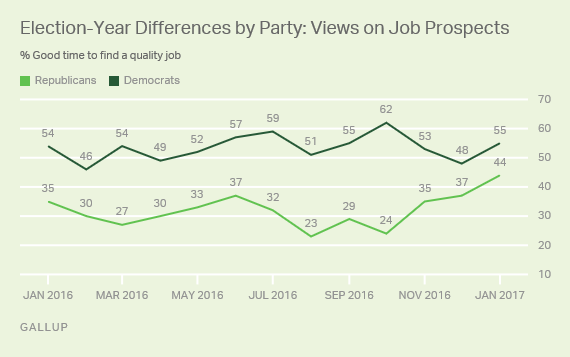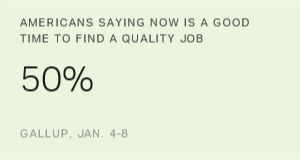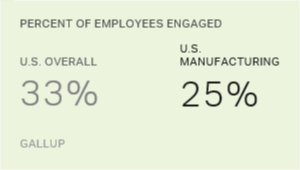Story Highlights
- Half of the public thinks now is a good time to find a quality job
- Gap between Republicans and Democrats has closed to within 11 points
WASHINGTON, D.C. -- Americans' optimism about the availability of good jobs in the U.S. surged in January to its highest level in more than 15 years of Gallup polling on the subject. Fifty percent say now is a good time to find a quality job, up seven percentage points from December and two points above the previous high recorded in January 2007.

The previous high of 48% in January 2007 was followed by a three-year slide during the recession, to the point that only 9% in January 2010 thought it was a good time to find a quality job. The annual average grew each year from 10% in 2009 to 42% in 2015 and remained at that level in 2016.
As Election Neared, Politics Played a Big Part in Views on Good Jobs
While 55% of Democrats say now is a good time to find a quality job, 44% of Republicans say the same -- an 11-point gap. This gap is much smaller than it was during the presidential campaign last year, which had a major impact on views about the availability of good jobs.
Members of the party holding the presidency tend to be more positive about the economy than are those of the opposition party, and the gap can grow in the heat of a presidential campaign. At the start of 2016, there was a 19-point gap in Democrats' vs. Republicans' perceptions that it was a good time to get a quality job (54% vs. 35%, respectively). This swelled to 38 points by October, when 62% of Democrats said it was a good time, compared with 24% of Republicans. Now, with the campaign over, the gap has shrunk.

Gallup has documented similar party shifts in economic confidence since the election.
Key Groups With High Unemployment Rates Think Good Jobs Are Available
Among the more likely to say now is a good time to find a quality job are those in a good position regarding employment:
- Sixty-two percent of those with a postgraduate education say now is a good time to find a quality job.
- Fifty-seven percent of those with an annual household income of $75,000 or more say it is a good time.
- Fifty-six percent of those who are employed say it is a good time.
However, some key groups with higher-than-average unemployment rates also are among the more positive about finding good jobs:
- Fifty-seven percent of nonwhites say now is a good time, compared with 47% of whites, though nonwhites are more likely to be unemployed.
- Fifty-four percent of those younger than 35 versus 48% of those aged 35 and older think it is a good time, though the younger group is more likely to be unemployed.
- Fifty-four percent of men say now is a good time to find a quality job, compared with 46% of women, though the unemployment rate is slightly higher for men.
Bottom Line
Americans have entered the new year relatively optimistic about the chances for job seekers to find quality employment. With the election behind them but Donald Trump not yet inaugurated, Republicans are more optimistic as they look forward to a Republican president taking office -- while Democrats are generally positive based on their belief that the Obama presidency has been good for the economy.
Political attitudes can be expected to have their usual effect over the next year on views about how easy it is to find a good job. Once Trump takes office, Democrats may develop a more negative view of the job market while Republicans' outlook improves even more. But the unemployment rate is a powerful driver of American views on the subject, and that is unlikely to change much in the next few months.
Historical data are available in Gallup Analytics.
Survey Methods
Results for this Gallup poll are based on telephone interviews conducted Jan. 4-8, 2017, with a random sample of 1,032 adults, aged 18 and older, living in all 50 U.S. states and the District of Columbia. For results based on the total sample of national adults, the margin of sampling error is ±4 percentage points at the 95% confidence level. All reported margins of sampling error include computed design effects for weighting.
Each sample of national adults includes a minimum quota of 70% cellphone respondents and 30% landline respondents, with additional minimum quotas by time zone within region. Landline and cellular telephone numbers are selected using random-digit-dial methods.
View complete question responses and trends.
Learn more about how the Gallup Poll Social Series works.





